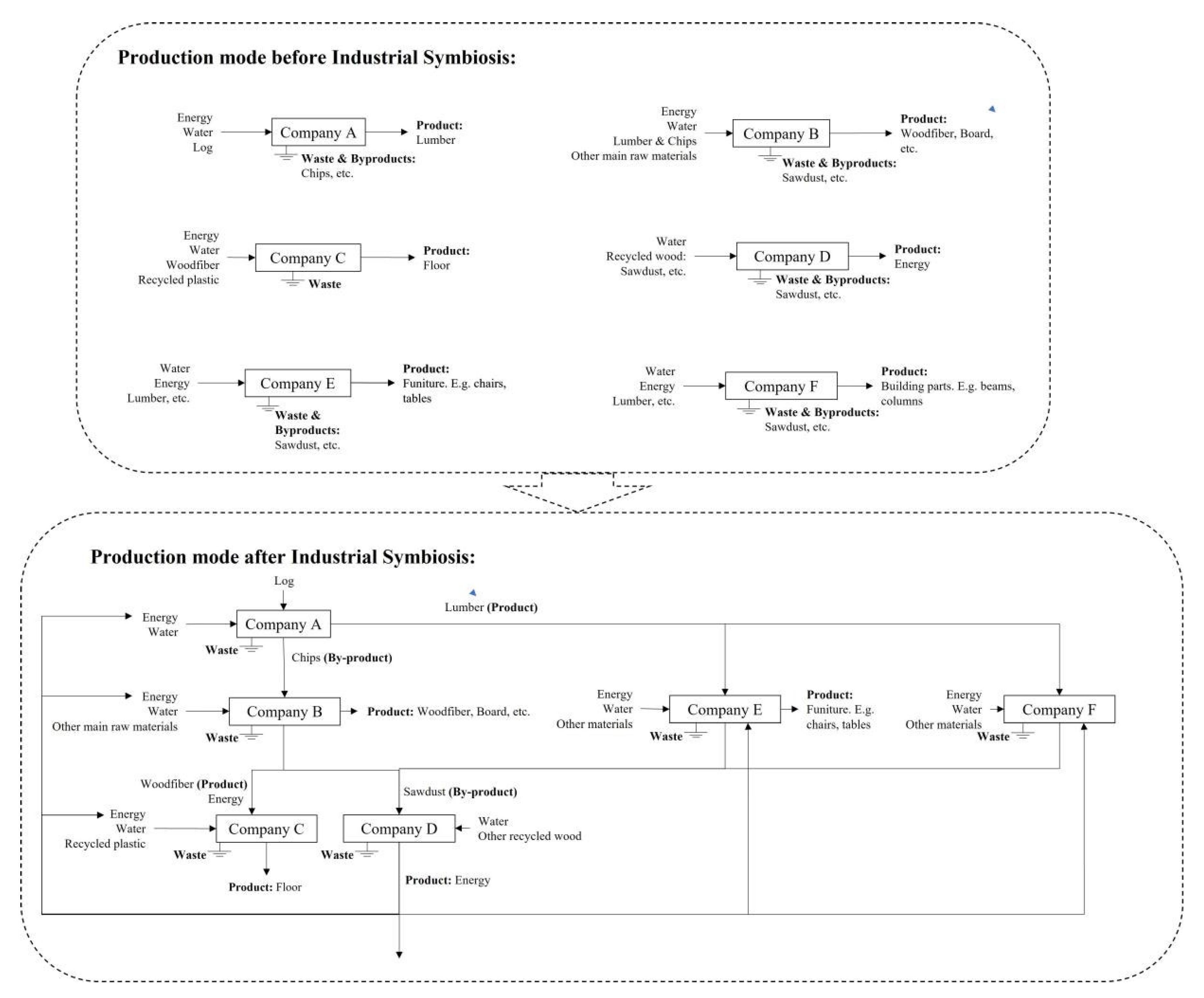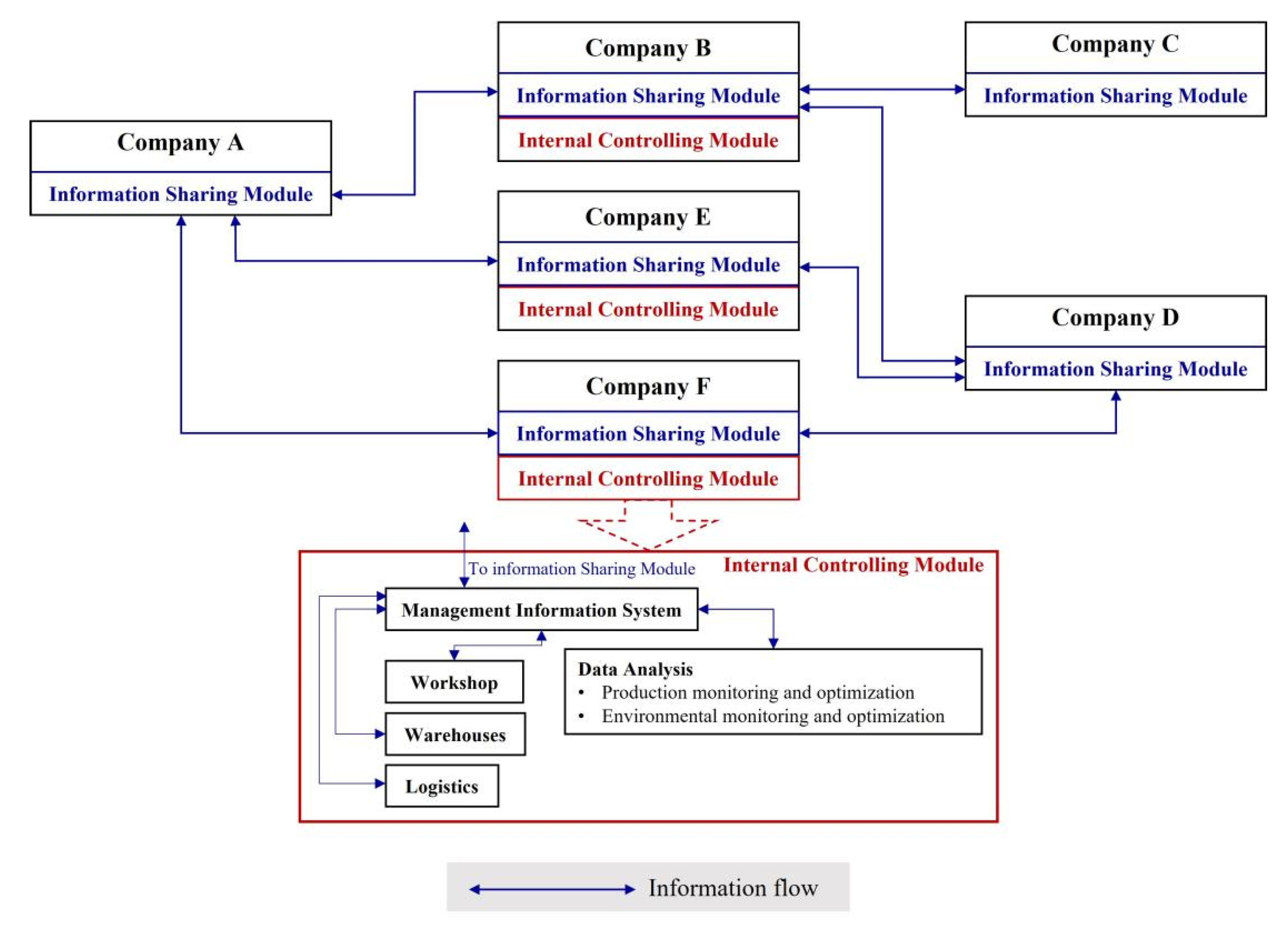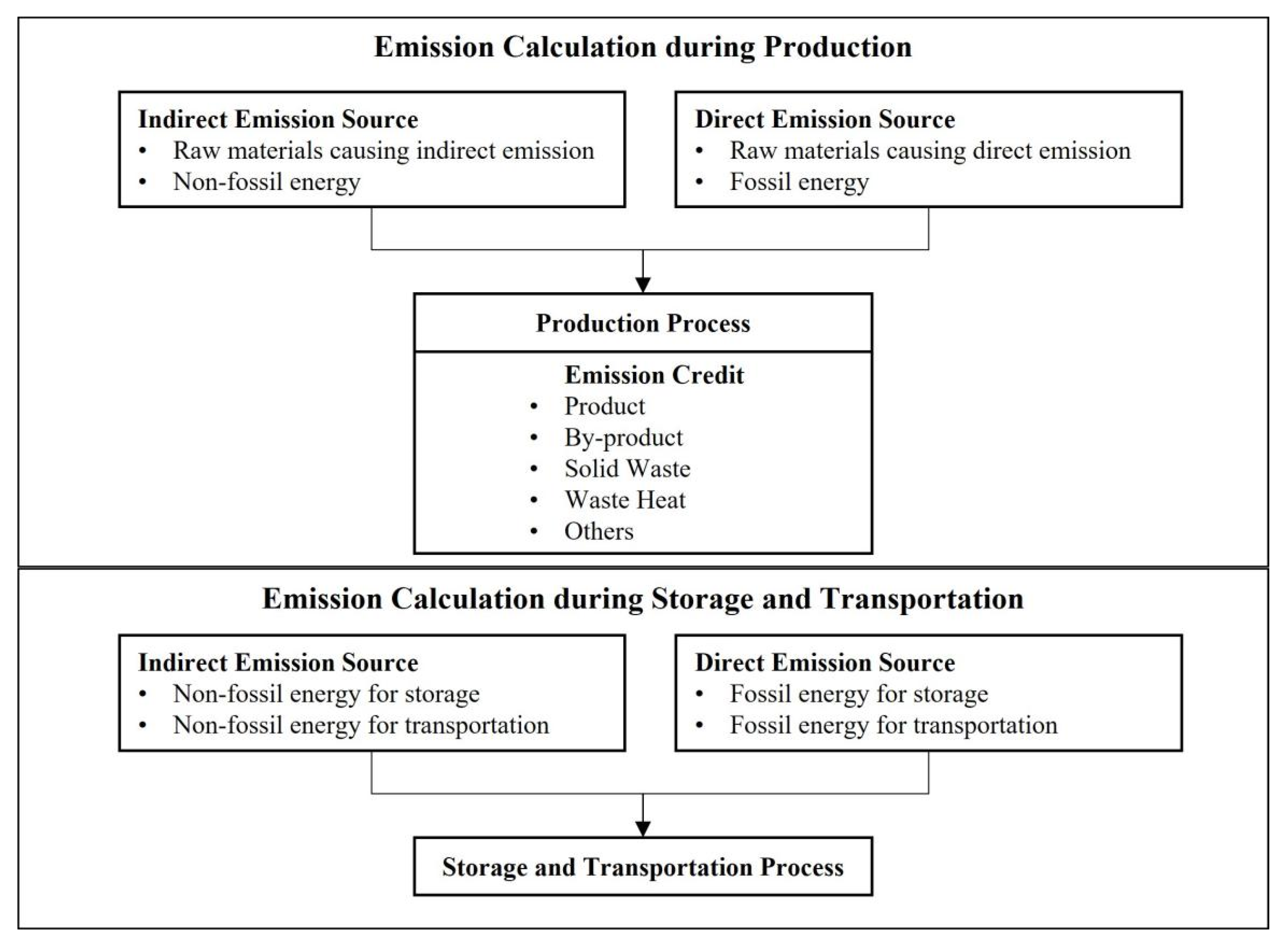Leveraging Digital Twins to Support Industrial Symbiosis Networks: A Case Study in the Norwegian Wood Supply Chain Collaboration
Abstract
:1. Introduction
2. Literature Review
2.1. Supply Chain Collaboration in Industrial Symbiosis
2.2. Digital Twins Applications
3. Materials and Methodology
3.1. Materials
3.2. Methods
3.2.1. Theoretical Basis
3.2.2. Data Collection
3.2.3. Data Analysis
4. Analysis Results
4.1. Need from Environmental Dimension
“Our carbon emissions are mainly from transportation, it depends on the location of the companies that orders from us, and we cannot control that”;
“Most of the waste are recycled within our company”;
“We use the waste wood in the production process as the heat source for office heating in winter”;
“Our raw materials are all packed in airtight containers, and there is very little waste, so it is difficult to reduce emissions currently”.
“Digital twin can monitor and evaluate the environmental impact of the company’s production process, especially carbon emissions”.
4.2. Need from Economic Dimension
“Our company has fewer than 5 long-term employees, so we don’t have enough people to do things. If the cost of digital twin is not high, we can consider. For example, use cloud storage to save equipment and labour costs”;
“Company cloud network is a simple and easy information sharing solution for our small business”.
“We hope the effect of being as obvious as possible.”
“If the price is high, but it can bring continuous benefits to the company, why not?”
“Platforms that are efficient are often more expensive, which is normal and acceptable. It mainly depends on whether the system is easy to use”;
“If the functions are practical and cannot be provided by other similar platforms, It’s understandable that the price is slightly higher”.
4.3. Need from Technical Dimension
“This digital twin is just a platform for sharing information with other companies, and there is no need to integrate the company’s production data”.
“Have fewer employees and a single business. It is enough for only one specialist to communicate with customers on product and by-product information and transportation issues through digital twin”.
“It should be limited in sharing information with other (companies) and monitoring logistics”;
“Our main business is simple. Information sharing is enough. Many big companies require complex internal management functions. We don’t need it”.
“Hope to centralize internal data on digital twin, so different levels of workers and departments can get their own operating platform but can also share information”.
“These data should be used to support production and management decision-making”;
“We hope to obtain as much information as possible about the available recycled raw materials for production”;
“We have a large number of employees. I hope this system can provide different employees with different permissions and operating interfaces”.
“Because the quality of recyclable raw materials is inconsistent, we need to test each batch of raw materials. We hope to realize the internal communication from laboratory testing to workshop production”.
“Employing specialists and training employees is indispensable for digitalization…great help to the efficient use of the digital twin platform”;
“We hope to operate and maintain digital twin by ourselves, because this digital twin is associated with a lot of internal data. We do this for security reasons”;
“If the third party leak company’s confidential data, we will face great losses, so we must avoid it”.
5. Discussions
5.1. Framework from User Perspective
5.2. Digital Twin-Based Information Sharing Framework between Companies
5.3. Emission Evaluation
6. Conclusions
Author Contributions
Funding
Institutional Review Board Statement
Informed Consent Statement
Data Availability Statement
Acknowledgments
Conflicts of Interest
Appendix A
- Company information
- (1)
- Company scale
- (2)
- Cooperation with downstream companies: age of company–company relationship; formal or informal tie; independency; age of individual–individual relationship; frequency/duration of projects with this company
- Personal information
- (1)
- Position
- (2)
- Working time in the industry
- (3)
- Working time in this position
- (4)
- Number of participating cooperation
- Product sales
- (1)
- Product type
- (2)
- Cooperated company, time, and mode
- By-products and their disposal
- (1)
- Types and disposal methods
- (2)
- Cooperated company, time, and mode
- Differences and similarities between selling waste and selling products
- Function Demand
- (1)
- Demand before sale
- (2)
- Demand in the sales process
- (3)
- Demand after sale
- Structure Demand
- (1)
- System construction: top-down or bottom-up
- (2)
- System maintenance: budget, training and outsourcing
- Company information
- (1)
- Company scale
- (2)
- Cooperation with upstream companies: age of company–company relationship; formal or informal tie; independency; age of individual–individual relationship; frequency/duration of projects with this company
- Personal information
- (1)
- Position
- (2)
- Working time in the industry
- (2)
- Working time in this position
- (4)
- Number of participating cooperation
- Raw material procurement
- (1)
- Type of the raw material
- (2)
- Cooperated company, time, and mode
- The procurement of recycled materials
- (1)
- Type of the recycled material
- (2)
- Cooperated company, time, and mode
- Differences and similarities between purchasing recycled materials and raw materials
- Function Demand
- (1)
- Demand before purchase
- (2)
- Demand in the purchase process
- (3)
- Demand after purchase
- Structure Demand
- (1)
- System construction: top-down or bottom-up
- (2)
- System maintenance: budget, training and outsourcing
References
- Domenech, T.; Bleischwitz, R.; Doranova, A.; Panayotopoulos, D.; Roman, L. Mapping Industrial Symbiosis Development in Europe_ typologies of networks, characteristics, performance and contribution to the Circular Economy. Resour. Conserv. Recycl. 2019, 141, 76–98. [Google Scholar] [CrossRef]
- Mirabella, N.; Castellani, V.; Sala, S. Current options for the valorization of food manufacturing waste: A review. J. Clean. Prod. 2014, 65, 28–41. [Google Scholar] [CrossRef]
- Herczeg, G.; Akkerman, R.; Hauschild, M.Z. Supply chain collaboration in industrial symbiosis networks. J. Clean. Prod. 2018, 171, 1058–1067. [Google Scholar] [CrossRef]
- Rymarczyk, J. Technologies, opportunities and challenges of the industrial revolution 4.0: Theoretical considerations. Entrep. Bus. Econ. Rev. 2020, 8, 185–198. [Google Scholar] [CrossRef]
- Ameri, F.; Sabbagh, R. Digital Factories for Capability Modeling and Visualization, IFIP Advances in Information and Communication Technology. In Proceedings of the IFIP International Conference on Advances in Production Management Systems (APMS), Iguassu Falls, Brazil, 3–7 September 2016; Volume 488, pp. 69–78. [Google Scholar]
- Avventuroso, G.; Silvestri, M.; Pedrazzoli, P. A Networked Production System to Implement Virtual Enterprise and Product Lifecycle Information Loops. IFAC-PapersOnLine 2017, 50, 7964–7969. [Google Scholar] [CrossRef]
- Chen, Z.; Huang, L. Digital twins for information-sharing in remanufacturing supply chain: A review. Energy 2021, 220, 119712. [Google Scholar] [CrossRef]
- Marty, C.; Yu, J.; Martin, G.; Bornoff, R.; Poppe, A.; Fournier, D.; Morard, E. Design flow for the development of optimized LED luminaires using multi-domain compact model simulations. In Proceedings of the THERMINIC 2018—24th International Workshop on Thermal Investigations of ICs and Systems, Stockholm, Sweden, 26–28 September 2018; IEEE: Stockholm, Sweden, 2018. [Google Scholar] [CrossRef]
- Lutters, E. Pilot production environments driven by digital twins. S. Afr. J. Ind. Eng. 2018, 29, 40–53. [Google Scholar] [CrossRef]
- Clark, T.; Barn, B.; Kulkarni, V.; Barat, S. Language Support for Multi Agent Reinforcement Learning. ACM Int. Conf. Proceeding Ser. 2020. [Google Scholar] [CrossRef]
- Ghobakhloo, M. The future of manufacturing industry: A strategic roadmap toward Industry 4.0. J. Manuf. Technol. Manag. 2018, 29, 910–936. [Google Scholar] [CrossRef] [Green Version]
- Hughes, L.; Dwivedi, Y.K.; Rana, N.P.; Williams, M.D.; Raghavan, V. Perspectives on the future of manufacturing within the Industry 4.0 era. Prod. Plan. Control. 2022, 33, 138–158. [Google Scholar] [CrossRef]
- Ivanov, D.; Dolgui, A. A digital supply chain twin for managing the disruption risks and resilience in the era of Industry 4.0. Prod. Plan. Control. 2021, 32, 775–788. [Google Scholar] [CrossRef]
- Chen, Z.; Huang, L. The impact of digital twins on local industry symbiosis networks in light of the uncertainty caused by the public crisis. Int. J. Inf. Syst. Supply Chain. Manag. 2022, 15, 1–28. [Google Scholar]
- Park, K.T.; Son, Y.H.; Noh, S.D. The architectural framework of a cyber physical logistics system for digital-twin-based supply chain control. Int. J. Prod. Res. 2020, 59, 5721–5742. [Google Scholar] [CrossRef]
- Wang, X.V.; Wang, L. Digital twin-based WEEE recycling, recovery and remanufacturing in the background of Industry 4.0. Int. J. Prod. Res. 2019, 57, 3892–3902. [Google Scholar] [CrossRef]
- Zheng, X.; Lu, J.; Kiritsis, D. The emergence of cognitive digital twin: Vision, challenges and opportunities. Int. J. Prod. Res. 2021, 60, 7610–7632. [Google Scholar] [CrossRef]
- VanDerHorn, E.; Mahadevan, S. Digital Twin: Generalization, characterization and implementation. Decis. Support Syst. 2021, 145, 113524. [Google Scholar] [CrossRef]
- Smetana, S.; Aganovic, K.; Heinz, V. Food Supply Chains as Cyber-Physical Systems: A Path for More Sustainable Personalized Nutrition. Food Eng. Rev. 2021, 13, 92–103. [Google Scholar] [CrossRef]
- Dolgui, A.; Ivanov, D.; Sokolov, B. Reconfigurable supply chain: The X-network. Int. J. Prod. Res. 2020, 58, 4138–4163. [Google Scholar] [CrossRef]
- Alles, M.; Gray, G.L. “The first mile problem”: Deriving an endogenous demand for auditing in blockchain-based business processes. Int. J. Account. Inf. Syst. 2020, 38, 100465. [Google Scholar] [CrossRef]
- Klerkx, L.; Jakku, E.; Labarthe, P. A review of social science on digital agriculture, smart farming and agriculture 4.0: New contributions and a future research agenda. NJAS-Wagening. J. Life Sci. 2019, 90, 100315. [Google Scholar] [CrossRef]
- Defraeye, T.; Tagliavini, G.; Wu, W.; Prawiranto, K.; Schudel, S.; Kerisima, M.A.; Verboven, P.; Bühlmann, A. Digital twins probe into food cooling and biochemical quality changes for reducing losses in refrigerated supply chains. Resour. Conserv. Recycl. 2019, 149, 778–794. [Google Scholar] [CrossRef]
- Ma, S.; Zhang, Y.; Liu, Y.; Yang, H.; Lv, J.; Ren, S. Data-driven sustainable intelligent manufacturing based on demand response for energy-intensive industries. J. Clean. Prod. 2020, 274, 123155. [Google Scholar] [CrossRef]
- Al-Saeed, Y.; Edwards, D.J.; Scaysbrook, S. Automating construction manufacturing procedures using BIM digital objects (BDOs): Case study of knowledge transfer partnership project in UK. Constr. Innov. 2020, 20, 345–377. [Google Scholar] [CrossRef]
- Greif, T.; Stein, N.; Flath, C.M. Peeking into the void: Digital twins for construction site logistics. Comput. Ind. 2020, 121, 103264. [Google Scholar] [CrossRef]
- Marmolejo-Saucedo, J.A. Design and Development of Digital Twins: A Case Study in Supply Chains. Mob. Netw. Appl. 2020, 25, 2141–2160. [Google Scholar] [CrossRef]
- Semenov, Y.; Semenova, O.; Kuvataev, I. Solutions for Digitalization of the Coal Industry Implemented in UC Kuzbassrazrezugol. E3S Web Conf. 2020, 174. [Google Scholar] [CrossRef]
- Frankó, A.; Vida, G.; Varga, P. Reliable identification schemes for asset and production tracking in industry 4.0. Sensors 2020, 20, 3709. [Google Scholar] [CrossRef]
- Tozanli, O.; Kongar, E.; Gupta, S.M. Evaluation of waste electronic product trade-in strategies in predictive twin disassembly systems in the era of blockchain. Sustainability 2020, 12, 5416. [Google Scholar] [CrossRef]
- Barykin, S.Y.; Bochkarev, A.A.; Kalinina, O.V.; Yadykin, V.K. Concept for a supply chain digital twin. Int. J. Math. Eng. Manag. Sci. 2020, 5, 1498–1515. [Google Scholar] [CrossRef]
- Sundarakani, B.; Pereira, V.; Ishizaka, A. Robust facility location decisions for resilient sustainable supply chain performance in the face of disruptions. Int. J. Logist. Manag. 2020, 32, 357–385. [Google Scholar] [CrossRef]
- Ivanov, D. Predicting the impacts of epidemic outbreaks on global supply chains: A simulation-based analysis on the coronavirus outbreak (COVID-19/SARS-CoV-2) case. Transp. Res. Part E: Logist. Transp. Rev. 2020, 136, 101922. [Google Scholar] [CrossRef]
- Smith, M.J. Getting value from artificial intelligence in agriculture. Anim. Prod. Sci. 2019, 60, 46–54. [Google Scholar] [CrossRef]
- Onwude, D.I.; Chen, G.; Eke-Emezie, N.; Kabutey, A.; Khaled, A.Y.; Sturm, B. Recent advances in reducing food losses in the supply chain of fresh agricultural produce. Processes 2020, 8, 1431. [Google Scholar] [CrossRef]
- Kadir, B.A.; Broberg, O. Human-centered design of work systems in the transition to industry 4.0. Appl. Ergon. 2021, 92, 103334. [Google Scholar] [CrossRef]
- Adeoye-Olatunde, O.A.; Olenik, N.L. Research and scholarly methods: Semi-structured interviews. JACCP J. Am. Coll. Clin. Pharm. 2021, 4, 1358–1367. [Google Scholar] [CrossRef]
- Yu, Y.; Li, Y.; Yang, B.; Susilo, W.; Yang, G.; Bai, J. Attribute-Based Cloud Data Integrity Auditing for Secure Outsourced Storage. IEEE Trans. Emerg. Top. Comput. 2020, 8, 377–390. [Google Scholar] [CrossRef] [Green Version]
- Padalkar, N.R.; Sheikh-Zadeh, A.; Song, J. Business value of smart contract: Case of inventory information discrepancies. In Proceedings of the 26th Americas Conference on Information Systems, Salt Lake City, UT, USA, 15–17 August 2020. [Google Scholar]



| Research Gaps | Contributions |
|---|---|
| Most prior studies employed engineering simulation methods rather than qualitative ones. | We apply the qualitative method of interviews to explore user demands as regards digital twins, and then provide insights as regards their design and applications. |
| Most prior researchers developed their studies from the perspective of technical pushes, which lacks either theoretical grounds or the demands of market pulls. | We investigate the potential needs of digital twins for industrial symbiosis from the user perspective. |
| Most extant literature applied digital twins in the manufacturing industry, regardless of achieving industrial symbiosis, circular economy transitions or supply chain construction. | We expound the application scenario of digital twins by demonstrating its potential for achieving industrial symbiosis as well as supply chain collaborations in the wood industry. |
| Aggregate Dimensions | Second-Order Themes | First-Order Concepts |
|---|---|---|
| Suppliers, small-size manufacturers and energy providers tend to standardize top-down digital twin | Flat structure meets the needs of small companies for inter-company information-sharing. | Separate from other management systems such as production system. Only used as an information-sharing tool between companies. Due to the small size of the company, a single authority is sufficient for obtain and exchange information. |
| Functional requirements concentrating on information-sharing for single business type. | Before production: information acquisition regarding raw materials and orders. In production: real-time monitoring of the logistics. Due to the small size of the company, complicated functions are not required. | |
| Cost is the main consideration. | The equipment and labor costs are as low as possible. A third party operates and maintains the digital twin. | |
| Big-size manufacturers tend to customize bottom-up digital twins | Comprehensive multi-level structure to meet the needs of internal management and external information exchange. | Highly integrated database for multiple departments. Managing a variety of internal processes. Sharing some of the data with other companies. Different operational interfaces for employees with different permissions. |
| Diversified functional requirements applied to different processes. | Before production: information acquisition of raw materials and orders. In production: real-time monitoring of production, environmental and cost assessment. After production: data storage and reuse. | |
| The efficiency and security of the system are the main considerations. | Train employees and hire specialists to ensure the efficiency of the digital twin. Operation and maintenance of the digital twin by the company itself to ensure the security of internal data. |
Disclaimer/Publisher’s Note: The statements, opinions and data contained in all publications are solely those of the individual author(s) and contributor(s) and not of MDPI and/or the editor(s). MDPI and/or the editor(s) disclaim responsibility for any injury to people or property resulting from any ideas, methods, instructions or products referred to in the content. |
© 2023 by the authors. Licensee MDPI, Basel, Switzerland. This article is an open access article distributed under the terms and conditions of the Creative Commons Attribution (CC BY) license (https://creativecommons.org/licenses/by/4.0/).
Share and Cite
Liu, Z.; Hansen, D.W.; Chen, Z. Leveraging Digital Twins to Support Industrial Symbiosis Networks: A Case Study in the Norwegian Wood Supply Chain Collaboration. Sustainability 2023, 15, 2647. https://doi.org/10.3390/su15032647
Liu Z, Hansen DW, Chen Z. Leveraging Digital Twins to Support Industrial Symbiosis Networks: A Case Study in the Norwegian Wood Supply Chain Collaboration. Sustainability. 2023; 15(3):2647. https://doi.org/10.3390/su15032647
Chicago/Turabian StyleLiu, Zhenyuan, Daniel Wilhelm Hansen, and Ziyue Chen. 2023. "Leveraging Digital Twins to Support Industrial Symbiosis Networks: A Case Study in the Norwegian Wood Supply Chain Collaboration" Sustainability 15, no. 3: 2647. https://doi.org/10.3390/su15032647
APA StyleLiu, Z., Hansen, D. W., & Chen, Z. (2023). Leveraging Digital Twins to Support Industrial Symbiosis Networks: A Case Study in the Norwegian Wood Supply Chain Collaboration. Sustainability, 15(3), 2647. https://doi.org/10.3390/su15032647







